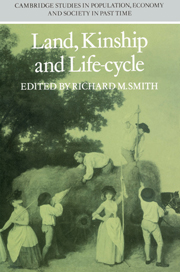Book contents
- Frontmatter
- Contents
- List of contributors
- Preface
- 1 Some issues concerning families and their property in rural England 1250–1800
- 2 Population pressure, inheritance and the land market in a fourteenth-century peasant community
- 3 Families and their land in an area of partible inheritance: Redgrave, Suffolk 1260–1320
- 4 Population changes and the transfer of customary land on a Cambridgeshire manor in the fourteenth century
- 5 Industrial employment and the rural land market 1380– 1520
- 6 Changes in the size of peasant holdings in some west midland villages 1400–1540
- 7 The erosion of the family–land bond in the late fourteenth and fifteenth centuries: a methodological note
- 8 Changes in the link between families and land in the west midlands in the fourteenth and fifteenth centuries
- 9 Kinship in an English village: Terling, Essex 1550–1700
- 10 The myth of the peasantry: family and economy in a northern parish
- 11 Poverty, poor relief and the life-cycle: some evidence from seventeenth-century Norfolk
- 12 The receipt of poor relief and family situation: Aldenham, Hertfordshire 1630–90
- 13 Widows in pre-industrial society: an essay upon their economic functions
- 14 Real property, marriage and children: the evidence from four pre-industrial communities
- 15 The nineteenth-century peasantry of Melbourn, Cambridgeshire
- Consolidated Bibliography
- Index
3 - Families and their land in an area of partible inheritance: Redgrave, Suffolk 1260–1320
Published online by Cambridge University Press: 19 October 2009
- Frontmatter
- Contents
- List of contributors
- Preface
- 1 Some issues concerning families and their property in rural England 1250–1800
- 2 Population pressure, inheritance and the land market in a fourteenth-century peasant community
- 3 Families and their land in an area of partible inheritance: Redgrave, Suffolk 1260–1320
- 4 Population changes and the transfer of customary land on a Cambridgeshire manor in the fourteenth century
- 5 Industrial employment and the rural land market 1380– 1520
- 6 Changes in the size of peasant holdings in some west midland villages 1400–1540
- 7 The erosion of the family–land bond in the late fourteenth and fifteenth centuries: a methodological note
- 8 Changes in the link between families and land in the west midlands in the fourteenth and fifteenth centuries
- 9 Kinship in an English village: Terling, Essex 1550–1700
- 10 The myth of the peasantry: family and economy in a northern parish
- 11 Poverty, poor relief and the life-cycle: some evidence from seventeenth-century Norfolk
- 12 The receipt of poor relief and family situation: Aldenham, Hertfordshire 1630–90
- 13 Widows in pre-industrial society: an essay upon their economic functions
- 14 Real property, marriage and children: the evidence from four pre-industrial communities
- 15 The nineteenth-century peasantry of Melbourn, Cambridgeshire
- Consolidated Bibliography
- Index
Summary
In his classic discussion of inheritance customs and practices in the thirteenth century, published over forty years ago, G. C. Homans gave much attention to the relationship between the rural family and its land in the areas of impartibility that coincided with ‘champion’ England. His reflections on the areas where partible inheritance prevailed were, by contrast, brief and confined mainly to evidence of Kentish gavelkind. He did, nonetheless, use the Kentish findings as a basis for more general remarks about multigeniture that were, he believed, applicable to medieval East Anglian society, where he noted there was considerable evidence for partible inheritance on both socage and customary land.
Homans, considering Kentish gavelkind, assessed the likely differences in social organization stemming from practices on the one hand which allowed or encouraged co-heirs to subdivide their inheritances and to hold their shares individually and from those on the other which led to the co-heirs living together in common. He believed that Kentish families of the thirteenth and early fourteenth centuries ‘must have resembled those that still existed in Auvergne, the Nivernais, and other parts of France in the nineteenth century: descendants of a common ancestor living in one large house or in a small group of adjoining houses and holding a domain in common and undivided’. In fact, Homans preferred to stress the prevalence of what he termed ‘joint-family organisation’ in these areas.
- Type
- Chapter
- Information
- Land, Kinship and Life-Cycle , pp. 135 - 196Publisher: Cambridge University PressPrint publication year: 1985
- 6
- Cited by

